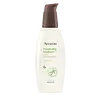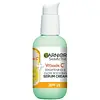Aveeno Positively Radiant Sheer Daily Face Moisturizer SPF 30 Versus Garnier Vitamin C 2-In-1 Brightening Serum Cream
What's inside
What's inside
 Key Ingredients
Key Ingredients

 Benefits
Benefits

 Concerns
Concerns

 Ingredients Side-by-side
Ingredients Side-by-side

Butyl Methoxydibenzoylmethane 1.5%
UV AbsorberHomosalate 5%
Skin ConditioningEthylhexyl Salicylate 4%
UV AbsorberOctocrylene 6%
UV AbsorberWater
Skin ConditioningCaprylyl Methicone
Skin ConditioningGlycerin
HumectantMethyl Methacrylate Crosspolymer
Glycine Soja Seed Extract
Skin ConditioningSodium Acryloyldimethyltaurate/Vp Crosspolymer
Emulsion StabilisingPentylene Glycol
Skin ConditioningHydroxyacetophenone
AntioxidantParfum
MaskingPhenoxyethanol
PreservativeGlyceryl Stearate
EmollientPolyacrylate-13
Chlorphenesin
AntimicrobialTocopheryl Acetate
AntioxidantSteareth-21
CleansingPolyisobutene
Disodium EDTA
Silica
AbrasivePolysorbate 20
EmulsifyingSodium Hydroxide
BufferingTitanium Dioxide
Cosmetic ColorantMica
Cosmetic ColorantButyl Methoxydibenzoylmethane 1.5%, Homosalate 5%, Ethylhexyl Salicylate 4%, Octocrylene 6%, Water, Caprylyl Methicone, Glycerin, Methyl Methacrylate Crosspolymer, Glycine Soja Seed Extract, Sodium Acryloyldimethyltaurate/Vp Crosspolymer, Pentylene Glycol, Hydroxyacetophenone, Parfum, Phenoxyethanol, Glyceryl Stearate, Polyacrylate-13, Chlorphenesin, Tocopheryl Acetate, Steareth-21, Polyisobutene, Disodium EDTA, Silica, Polysorbate 20, Sodium Hydroxide, Titanium Dioxide, Mica
Water
Skin ConditioningGlycerin
HumectantEthylhexyl Salicylate
UV AbsorberDimethicone
EmollientPhenylbenzimidazole Sulfonic Acid
UV AbsorberBis-Ethylhexyloxyphenol Methoxyphenyl Triazine
Skin ConditioningTriethanolamine
BufferingButyl Methoxydibenzoylmethane
UV AbsorberOctyldodecanol
EmollientIsopropyl Isostearate
EmollientCetyl Alcohol
EmollientBehenyl Alcohol
EmollientCitrus Limon Fruit Extract
MaskingCitrus Paradisi Fruit Extract
Skin ConditioningTin Oxide
AbrasiveStearic Acid
CleansingTitanium Dioxide
Cosmetic ColorantCetearyl Alcohol
EmollientCetearyl Glucoside
EmulsifyingPEG-100 Stearate
Sodium Hyaluronate
HumectantSodium Polyacrylate Starch
AbsorbentSodium Stearoyl Glutamate
CleansingSilica
AbrasiveMyristic Acid
CleansingPalmitic Acid
EmollientAdenosine
Skin ConditioningAscorbyl Glucoside
AntioxidantHydroxyacetophenone
AntioxidantCapryloyl Salicylic Acid
ExfoliatingCitric Acid
BufferingTrisodium Ethylenediamine Disuccinate
Poly C10-30 Alkyl Acrylate
Emulsion StabilisingChlorphenesin
AntimicrobialMica
Cosmetic ColorantCI 77891
Cosmetic ColorantLinalool
PerfumingGeraniol
PerfumingLimonene
PerfumingCitronellol
PerfumingParfum
MaskingWater, Glycerin, Ethylhexyl Salicylate, Dimethicone, Phenylbenzimidazole Sulfonic Acid, Bis-Ethylhexyloxyphenol Methoxyphenyl Triazine, Triethanolamine, Butyl Methoxydibenzoylmethane, Octyldodecanol, Isopropyl Isostearate, Cetyl Alcohol, Behenyl Alcohol, Citrus Limon Fruit Extract, Citrus Paradisi Fruit Extract, Tin Oxide, Stearic Acid, Titanium Dioxide, Cetearyl Alcohol, Cetearyl Glucoside, PEG-100 Stearate, Sodium Hyaluronate, Sodium Polyacrylate Starch, Sodium Stearoyl Glutamate, Silica, Myristic Acid, Palmitic Acid, Adenosine, Ascorbyl Glucoside, Hydroxyacetophenone, Capryloyl Salicylic Acid, Citric Acid, Trisodium Ethylenediamine Disuccinate, Poly C10-30 Alkyl Acrylate, Chlorphenesin, Mica, CI 77891, Linalool, Geraniol, Limonene, Citronellol, Parfum
 Reviews
Reviews

Ingredients Explained
These ingredients are found in both products.
Ingredients higher up in an ingredient list are typically present in a larger amount.
Also known as Avobenzone, this ingredient is a chemical sunscreen filter that provides protection in the UV-A range.
Avobenzone is globally approved and is the most commonly used UV-A filter in the world.
Studies have found that avobenzone becomes ineffective when exposed to UV light (it is not photostable; meaning that it breaks down in sunlight). Because of this, formulations that include avobenzone will usually contain stabilizers such as octocrylene.
However, some modern formulations (looking at you, EU!) are able to stabilize avobenzone by coating the molecules.
Avobenzone does not protect against the UV-B range, so it's important to check that the sunscreen you're using contains other UV filters that do!
The highest concentration of avobenzone permitted is 3% in the US, and 5% in the EU.
Learn more about Butyl MethoxydibenzoylmethaneChlorphenesin is a synthetic preservative. It helps protect a product against bacteria in order to extend shelf life. In most cases, Chlorphenesin is paired with other preservatives such as phenoxyethanol and caprylyl glycol.
Chlorphenesin is a biocide. This means it is able to help fight the microorganisms on our skin. It is also able to fight odor-releasing bacteria.
Chlorphenesin is soluble in both water and glycerin.
Studies show Chlorphenesin is easily absorbed by our skin. You should speak with a skincare professional if you have concerns about using Chlorphenesin.
Learn more about ChlorphenesinEthylhexyl Salicylate is an organic compound used to block UV rays. It primarily absorbs UVB rays but offers a small amount of UVA protection as well.
Commonly found in sunscreens, Ethylhexyl Salicylate is created from salicylic acid and 2-ethylhexanol. You might know salicylic acid as the effective acne fighter ingredient and BHA.
The ethylhexanol in this ingredient is a fatty alcohol and helps hydrate your skin, similar to oils. It is an emollient, which means it traps moisture into the skin.
According to manufacturers, Ethylhexyl Salicylate absorbs UV wavelength of 295-315 nm, with a peak absorption at 307-310 nm. UVA rays are linked to long term skin damage, such as hyperpigmentation. UVB rays emit more energy and are capable of damaging our DNA. UVB rays cause sunburn.
Learn more about Ethylhexyl SalicylateGlycerin is already naturally found in your skin. It helps moisturize and protect your skin.
A study from 2016 found glycerin to be more effective as a humectant than AHAs and hyaluronic acid.
As a humectant, it helps the skin stay hydrated by pulling moisture to your skin. The low molecular weight of glycerin allows it to pull moisture into the deeper layers of your skin.
Hydrated skin improves your skin barrier; Your skin barrier helps protect against irritants and bacteria.
Glycerin has also been found to have antimicrobial and antiviral properties. Due to these properties, glycerin is often used in wound and burn treatments.
In cosmetics, glycerin is usually derived from plants such as soybean or palm. However, it can also be sourced from animals, such as tallow or animal fat.
This ingredient is organic, colorless, odorless, and non-toxic.
Glycerin is the name for this ingredient in American English. British English uses Glycerol/Glycerine.
Learn more about GlycerinHydroxyacetophenone is antioxidant with skin conditioning and soothing properties. It also boosts the efficiency of preservatives.
This ingredient is not irritating or sensitizing.
Mica is a naturally occurring mineral used to add shimmer and color in cosmetics. It can also help improve the texture of a product or give it an opaque, white/silver color.
Serecite is the name for very fine but ragged grains of mica.
This ingredient is often coated with metal oxides like titanium dioxide. Trace amounts of heavy metals may be found in mica, but these metals are not harmful in our personal products.
Mica has been used since prehistoric times throughout the world. Ancient Egyptian, Indian, Greek, Roman, Aztec, and Chinese civilizations have used mica.
Learn more about MicaParfum is a catch-all term for an ingredient or more that is used to give a scent to products.
Also called "fragrance", this ingredient can be a blend of hundreds of chemicals or plant oils. This means every product with "fragrance" or "parfum" in the ingredients list is a different mixture.
For instance, Habanolide is a proprietary trade name for a specific aroma chemical. When used as a fragrance ingredient in cosmetics, most aroma chemicals fall under the broad labeling category of “FRAGRANCE” or “PARFUM” according to EU and US regulations.
The term 'parfum' or 'fragrance' is not regulated in many countries. In many cases, it is up to the brand to define this term.
For instance, many brands choose to label themselves as "fragrance-free" because they are not using synthetic fragrances. However, their products may still contain ingredients such as essential oils that are considered a fragrance by INCI standards.
One example is Calendula flower extract. Calendula is an essential oil that still imparts a scent or 'fragrance'.
Depending on the blend, the ingredients in the mixture can cause allergies and sensitivities on the skin. Some ingredients that are known EU allergens include linalool and citronellol.
Parfum can also be used to mask or cover an unpleasant scent.
The bottom line is: not all fragrances/parfum/ingredients are created equally. If you are worried about fragrances, we recommend taking a closer look at an ingredient. And of course, we always recommend speaking with a professional.
Learn more about ParfumSilica, also known as silicon dioxide, is a naturally occurring mineral. It is used as a fine, spherical, and porous powder in cosmetics.
Though it has exfoliant properties, the function of silica varies depending on the product.
The unique structure of silica enhances the spreadability and adds smoothness, making it a great texture enhancer.
It is also used as an active carrier, emulsifier, and mattifier due to its ability to absorb excess oil.
In some products, tiny microneedles called spicules are made from silica or hydrolyzed sponge. When you rub them in, they lightly polish away dead skin layers and enhance the penetration of active ingredients.
Learn more about SilicaTitanium dioxide is a mineral UV filter widely used in sunscreens and cosmetics.
It is one of only two UV filters officially classified as “mineral” by regulatory agencies, the other being zinc oxide.
Titanium dioxide provides broad-spectrum protection mostly in the UVB and UVAII range, with some protection in the UVAI range.
While its UVA protection isn’t as strong as zinc oxide’s, the difference is minor.
A common myth is that mineral UV filters reflect UV light. However, modern research shows titanium dioxide absorbs UV radiation like chemical filters (~95% absorption & 5% reflection).
Thanks to its non-irritating nature, titanium dioxide is suitable for sensitive, acne-prone, or redness-prone skin. It is unlikely to cause "eye sting" like other sunscreen ingredients.
A major drawback of this ingredient is its white cast and thick texture. This is why mineral sunscreens often leave a white cast and are less cosmetically elegant than chemical/hybrid sunscreens.
To improve white cast and spreadability, micronized or nano-sized titanium dioxide is often used.
There are ongoing concerns surrounding nano-titanium oxide's impact on marine ecosystems.
There is no conclusive evidence that any form of titanium oxide (or any other sunscreen ingredients) will cause harm to marine ecosystems or coral reefs. The science is still developing but many consumers are keeping a close eye on this issue.
Please note, many destinations have reef-safety sunscreen rules. For instance, the U.S. Virgin Islands advises all visitors to use non-nano mineral sunscreens.
Nano mineral sunscreens once raised safety concerns about absorption into skin.
Extensive research has shown that they do not penetrate healthy or damaged skin; they remain safely on the surface and the top layer of dead skin (stratum corneum).
You'll likely find titanium dioxide bundled with alumina, silica, or dimethicone. These ingredients help make titanium dioxide highly photostable; this prevents it from interacting with other formula components under UV light.
Learn more about Titanium DioxideWater. It's the most common cosmetic ingredient of all. You'll usually see it at the top of ingredient lists, meaning that it makes up the largest part of the product.
So why is it so popular? Water most often acts as a solvent - this means that it helps dissolve other ingredients into the formulation.
You'll also recognize water as that liquid we all need to stay alive. If you see this, drink a glass of water. Stay hydrated!
Learn more about Water